For the 2025 school year, there are 5 public schools serving 2,128 students in Forrest City School District. This district's average testing ranking is 1/10, which is in the bottom 50% of public schools in Arkansas.
Public Schools in Forrest City School District have an average math proficiency score of 15% (versus the Arkansas public school average of 39%), and reading proficiency score of 15% (versus the 40% statewide average).
Minority enrollment is 96% of the student body (majority Black), which is more than the Arkansas public school average of 42% (majority Black).
Overview
This School District
This State (AR)
# Schools
5 Schools
1,110 Schools
# Students
2,128 Students
485,111 Students
# Teachers
139 Teachers
38,779 Teachers
Student : Teacher Ratio
15:1
15:1
District Rank
Forrest City School District, which is ranked within the bottom 50% of all 258 school districts in Arkansas (based off of combined math and reading proficiency testing data) for the 2021-2022 school year.
The school district's graduation rate of 85-89% has increased from 75-79% over five school years.
Overall District Rank
#240 out of 259 school districts
(Bottom 50%)
(Bottom 50%)
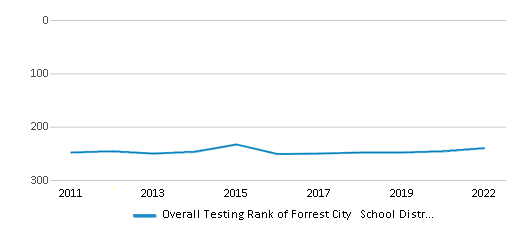
Math Test Scores (% Proficient)
14%
38%
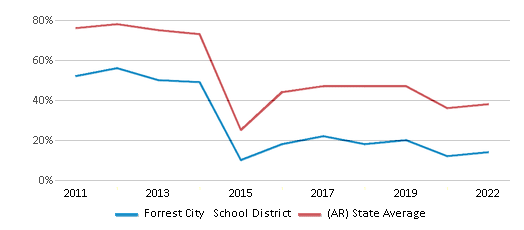
Reading/Language Arts Test Scores (% Proficient)
15%
40%
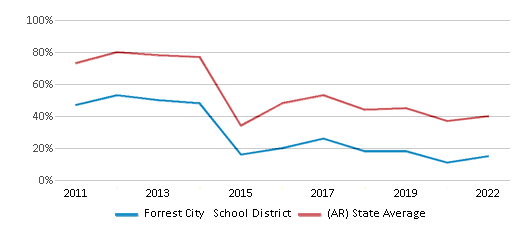
Science Test Scores (% Proficient)
13%
36%
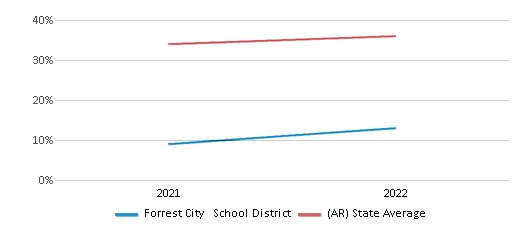
Graduation Rate
85-89%
88%
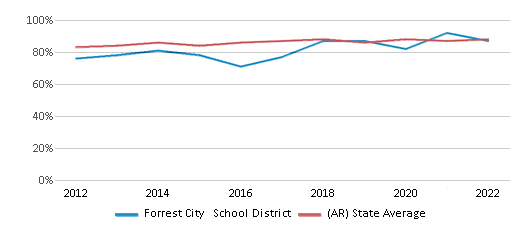
Students by Ethnicity:
Diversity Score
0.13
0.61
# American Indian Students
4 Students
2,795 Students
% American Indian Students
n/a
n/a
# Asian Students
15 Students
8,854 Students
% Asian Students
1%
2%
# Hispanic Students
31 Students
71,016 Students
% Hispanic Students
1%
15%
# Black Students
1,980 Students
94,274 Students
% Black Students
93%
19%
# White Students
87 Students
280,739 Students
% White Students
4%
58%
# Hawaiian Students
1 Student
4,966 Students
% Hawaiian Students
n/a
1%
# Two or more races Students
10 Students
22,677 Students
% of Two or more races Students
1%
5%
Students by Grade:
# Students in PK Grade:
203
10,102
# Students in K Grade:
171
34,850
# Students in 1st Grade:
175
35,859
# Students in 2nd Grade:
160
37,037
# Students in 3rd Grade:
149
35,957
# Students in 4th Grade:
132
35,919
# Students in 5th Grade:
137
35,951
# Students in 6th Grade:
155
36,175
# Students in 7th Grade:
137
36,641
# Students in 8th Grade:
141
37,270
# Students in 9th Grade:
143
39,879
# Students in 10th Grade:
152
39,369
# Students in 11th Grade:
163
37,430
# Students in 12th Grade:
110
32,498
# Ungraded Students:
-
174
District Revenue and Spending
The revenue/student of $13,878 is higher than the state median of $13,132. The school district revenue/student has grown by 7% over four school years.
The school district's spending/student of $13,287 is higher than the state median of $13,043. The school district spending/student has grown by 7% over four school years.
Total Revenue
$30 MM
$6,371 MM
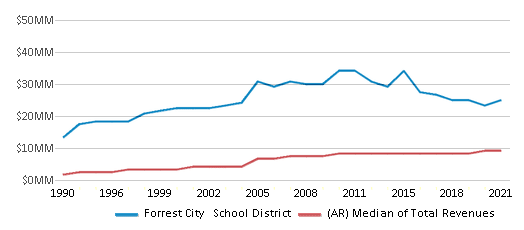
Spending
$28 MM
$6,327 MM
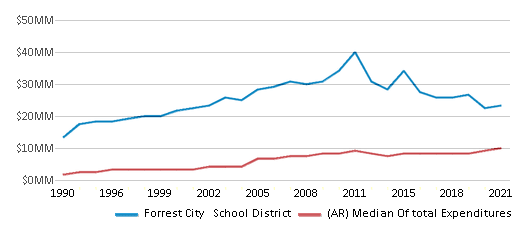
Revenue / Student
$13,878
$13,132
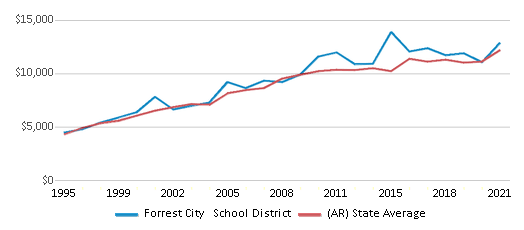
Spending / Student
$13,287
$13,043
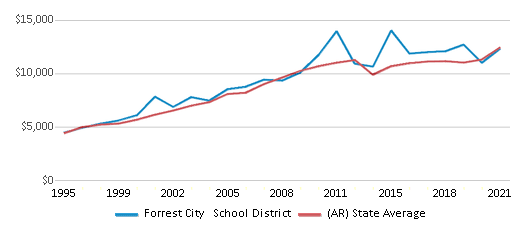
Best Forrest City School District Public Schools (2025)
School
(Math and Reading Proficiency)
(Math and Reading Proficiency)
Location
Grades
Students
Rank: #11.
Lincoln Academy
(Math: 20-24% | Reading: 15-19%)
Rank:
Rank:
2/
Bottom 50%10
616 W Broadway Ave
Forrest City, AR 72335
(870) 261-1810
Forrest City, AR 72335
(870) 261-1810
Grades: 6
| 155 students
Rank: #22.
Stewart Elementary School
(Math: 22% | Reading: 13%)
Rank:
Rank:
2/
Bottom 50%10
625 Irving St
Forrest City, AR 72335
(870) 633-1365
Forrest City, AR 72335
(870) 633-1365
Grades: 3-5
| 418 students
Rank: #33.
Forrest City Jr. High School
(Math: 8% | Reading: 19%)
Rank:
Rank:
1/
Bottom 50%10
1133 N Division St
Forrest City, AR 72335
(870) 633-3230
Forrest City, AR 72335
(870) 633-3230
Grades: 7-8
| 278 students
Rank: #44.
Forrest City High School
(Math: 6% | Reading: 15%)
Rank:
Rank:
1/
Bottom 50%10
467 Victoria St
Forrest City, AR 72335
(870) 633-1464
Forrest City, AR 72335
(870) 633-1464
Grades: 9-12
| 568 students
Rank: n/an/a
801 Deaderick Rd
Forrest City, AR 72335
(870) 633-2141
Forrest City, AR 72335
(870) 633-2141
Grades: PK-2
| 709 students
Frequently Asked Questions
How many schools belong to Forrest City School District?
Forrest City School District manages 5 public schools serving 2,128 students.
What is the rank of Forrest City School District?
Forrest City School District is ranked #237 out of 258 school districts in Arkansas (bottom 50%) based off of combined math and reading proficiency testing data for the 2021-2022 school year.
What is the racial composition of students in Forrest City School District?
93% of Forrest City School District students are Black, 4% of students are White, 1% of students are Asian, 1% of students are Hispanic, and 1% of students are Two or more races.
What is the student/teacher ratio of Forrest City School District?
Forrest City School District has a student/teacher ratio of 15:1, which is higher than the Arkansas state average of 13:1.
What is Forrest City School District's spending/student ratio?
The school district's spending/student of $13,287 is higher than the state median of $13,043. The school district spending/student has grown by 7% over four school years.
Recent Articles
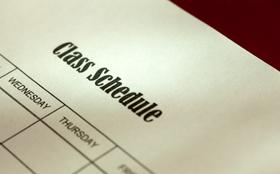
Year-Round Or Traditional Schedule?
Which is more appropriate for your child? A year-round attendance schedule or traditional schedule? We look at the pros and cons.

Why You Should Encourage Your Child to Join a Sports Team
Participating in team sports has a great many benefits for children, there is no doubt. In this article you will learn what those benefits are.

White Students are Now the Minority in U.S. Public Schools
Increasing birth rates among immigrant families from Asia and Central and South America, combined with lower birth rates among white families, means that for the first time in history, public school students in the United States are majority-minority. This shift in demographics poses difficulties for schools as they work to accommodate children of varying language abilities and socio-economic backgrounds.





